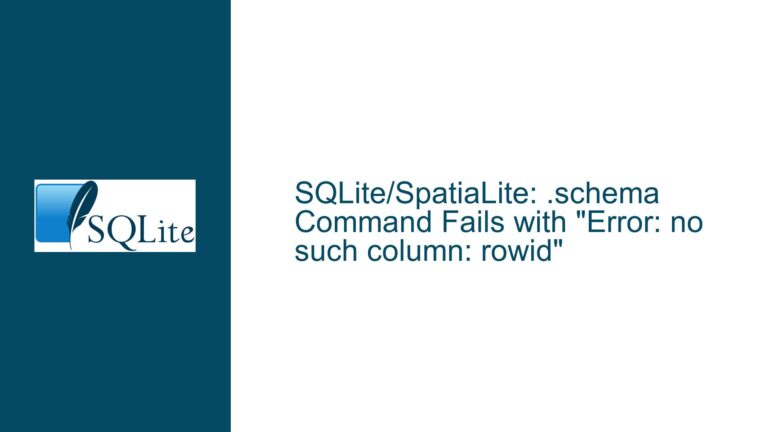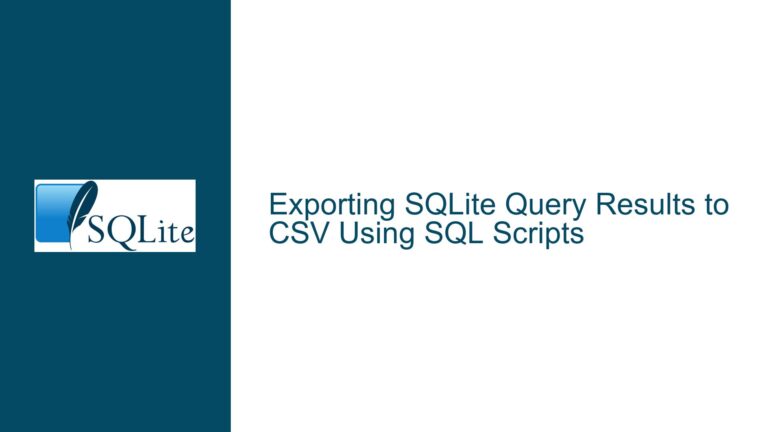Resolving Incorrect Middle Dot (U+00B7) Display in SQLite CLI on Windows PowerShell
Understanding the Mismatch Between Unicode Code Points, UTF-8 Encoding, and Windows Console Rendering
Issue Overview: Misinterpretation of Middle Dot (U+00B7) in SQLite CLI on Windows PowerShell
The core issue revolves around the incorrect display of the Unicode character U+00B7 (MIDDLE DOT) when using the SQLite command-line interface (CLI) on Windows PowerShell. Users attempting to output this character observe unexpected results:
- The query
SELECT '·';truncates text after the middle dot or displays an incorrect glyph (e.g.,'instead of·). - The same query works correctly in Linux environments (e.g., WSL2), where the middle dot renders as expected.
- Alternative methods, such as
SELECT CHAR(0xB7);, sometimes produce a different character (e.g.,・, U+30FB KATAKANA MIDDLE DOT) on Windows.
This discrepancy stems from three interrelated factors:
- Unicode Code Point vs. UTF-8 Encoding Confusion: The user conflated the Unicode code point U+00B7 with its UTF-8 byte sequence
0xC2 0xB7, leading to incorrect assumptions about how SQLite processes the character. - Windows Console Limitations: The SQLite CLI on Windows converts UTF-8 to the console’s legacy code page (e.g., CP437 or CP1252) via
sqlite3_win32_utf8_to_mbcs_v2(), which maps Unicode characters to glyphs available in the active code page. If the code page lacks support for U+00B7, substitution (e.g.,?) or incorrect glyphs occur. - Terminal Emulator Behavior: PowerShell and Windows Terminal handle UTF-8 output inconsistently compared to Linux terminals. Even with
chcp 65001(UTF-8 code page), rendering issues persist due to font limitations or terminal emulator bugs.
Root Causes: Encoding Missteps, Code Page Conflicts, and Terminal Quirks
1. Unicode Code Point vs. UTF-8 Encoding Ambiguity
- U+00B7 (MIDDLE DOT): Unicode code point
0x00B7corresponds to the UTF-8 byte sequence0xC2 0xB7. - U+C2B7 Misinterpretation: The user mistakenly referenced
U+C2B7(a non-existent code point) instead ofU+00B7. This confusion arises from interpreting UTF-8 bytes (C2 B7) as a hexadecimal code point (C2B7), which is invalid. - SQLite’s Text Handling: SQLite stores and retrieves text as UTF-8, UTF-16LE, or UTF-16BE, but the CLI’s display behavior depends on terminal capabilities.
2. Windows Console Code Page and Glyph Mapping
- Legacy Code Pages: Windows defaults to code pages like CP437 (US) or CP1252 (Western European), which lack glyphs for many Unicode characters, including U+00B7. For example:
- CP437: Maps
0xB7to·, but this conflicts with SQLite’s internal conversions. - CP1252: Includes
0xB7as·, but PowerShell often defaults to CP437.
- CP437: Maps
- UTF-8 Code Page (65001): While
chcp 65001enables UTF-8 support, many Windows applications (including PowerShell) struggle with rendering due to:- Font Limitations: The active font may not include glyphs for U+00B7.
- Buffer Bugs: Truncated output or misaligned cursors when printing multibyte UTF-8 sequences.
3. SQLite CLI’s Windows-Specific Output Handling
- Console Detection: The SQLite CLI checks if stdout is a console. If true, it converts UTF-8 to the console’s code page using
WideCharToMultiByte(), which maps Unicode to the nearest equivalent in the active code page. - Direct Output vs. Redirection: Redirecting output to a file (e.g.,
sqlite3.exe > output.txt) bypasses code page conversion, preserving raw UTF-8 bytes.
4. Language Settings and Fonts
- System Locale: Windows display language settings influence default code pages. For example, a Japanese locale may prioritize Shift-JIS mappings, causing
CHAR(0xB7)to resolve to・(U+30FB) instead of·. - Terminal Fonts: Fonts like Consolas or MS Gothic may lack glyphs for U+00B7, leading to fallback characters.
Resolving Display Issues: Encoding Corrections, Configuration Tweaks, and Workarounds
1. Clarify Encoding Practices
Use Unicode Code Points Explicitly:
Instead of typing·directly (prone to encoding mismatches), use SQLite’sCHAR()function with the Unicode code point value:SELECT CHAR(0x00B7); -- Unicode code point U+00B7This ensures SQLite interprets the value correctly, regardless of terminal encoding.
Hex Literals for UTF-8 Sequences:
For raw UTF-8 bytes, useCAST(X'...' AS TEXT):SELECT CAST(X'C2B7' AS TEXT); -- UTF-8 for U+00B7This bypasses terminal input issues by directly specifying the byte sequence.
2. Configure Windows Console for UTF-8
Enable UTF-8 Code Page:
Runchcp 65001in PowerShell to set the active code page to UTF-8. Combine this with:- Windows Terminal: Set the profile’s "Command line" to
pwsh.exe -NoExit -Command "chcp 65001"to enforce UTF-8 on startup. - Registry Edit: Enable UTF-8 system-wide via:
[HKEY_LOCAL_MACHINE\SYSTEM\CurrentControlSet\Control\Nls\CodePage] "ACP"="65001" "OEMCP"="65001"Note: Reboot required. Use cautiously, as legacy apps may break.
- Windows Terminal: Set the profile’s "Command line" to
Font Configuration:
In Windows Terminal, select a font with broad Unicode coverage (e.g., Cascadia Code, Noto Sans Mono).
3. Bypass Console Conversion
Redirect Output to File:
Capture raw UTF-8 output without console interference:.\sqlite3.exe "SELECT '·';" > output.txtOpen
output.txtin a UTF-8-aware editor (e.g., VS Code, Notepad++).Use PowerShell’s Pipeline:
Decode output as UTF-8 explicitly:[System.Text.Encoding]::UTF8.GetString((.\sqlite3.exe "SELECT '·';" | % { [Text.Encoding]::Default.GetBytes($_) }))
4. Modify SQLite CLI Behavior
Compile Custom CLI:
Disable automatic console conversion by modifyingshell.cin SQLite’s source:// Comment out or remove calls to sqlite3_win32_utf8_to_mbcs_v2() // in the console output logic.Recompile to emit raw UTF-8 regardless of output destination.
Use WSL or Linux Subsystems:
Run SQLite in WSL2, where UTF-8 handling is consistent with Linux.
5. Validate Environment Settings
- Check Active Code Page:
Verify withchcpin PowerShell. If not65001, revisit configuration steps. - Test Glyph Availability:
Use PowerShell to test if U+00B7 renders correctly:[System.Char]::ConvertFromUtf32(0x00B7)If this displays
·, the issue lies with SQLite CLI’s conversion. If not, adjust fonts or code pages.
6. Alternative Middle Dot Representations
- HTML Entities in Queries:
For web applications, use'·'and process externally. Not applicable to CLI. - ASCII Substitutes:
Temporarily use*or-if the middle dot is purely decorative.
Final Notes:
The root cause is not SQLite itself but the interplay between Windows console limitations, encoding settings, and font support. By aligning terminal configurations with UTF-8 standards and using explicit encoding methods in queries, users can reliably display U+00B7 and other Unicode characters. For mission-critical applications, consider redirecting output to files or using subsystems with robust UTF-8 support.






